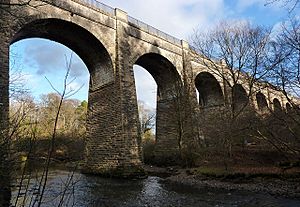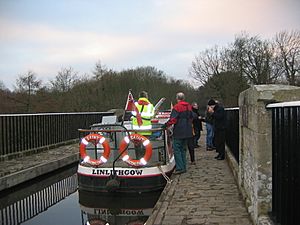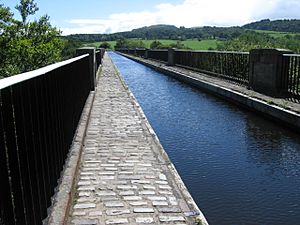Avon Aqueduct facts for kids
Quick facts for kids Avon Aqueduct |
|
|---|---|
 |
|
| Coordinates | 55°57′51″N 3°39′22″W / 55.964167°N 3.656111°W |
| Carries | Union Canal |
| Crosses | River Avon |
| Locale | Linlithgow |
| Characteristics | |
| Total length | 810 feet (250 m) |
| Height | 86 feet (26 m) |
| Longest span | 50 feet (15 m) |
| Number of spans | Twelve |
| History | |
| Designer | Hugh Baird |
The Avon Aqueduct is a special kind of bridge called a navigable aqueduct. It carries the Union Canal over the River Avon. You can find it near Linlithgow, in Scotland. This amazing structure allows boats to travel smoothly over the river below.
History of the Avon Aqueduct
The Avon Aqueduct was designed by an engineer named Hugh Baird. He also got advice from another famous engineer, Thomas Telford. They worked together on this aqueduct and two others, the Slateford and Lin's Mill aqueducts. All three share a similar design.
Thomas Telford wasn't sure if stone arches were needed along with the iron trough. But Baird decided to use both for all three big aqueducts. The construction of the Avon Aqueduct happened between 1819 and 1821. It was built by a company called Messrs. Craven, Whitaker and Nowell. They were chosen because they had successfully built a stone bridge over the River Ouse.
This aqueduct sits right on the border between two areas: West Lothian and Falkirk. Because of this, it has two official listings with Historic Environment Scotland. The Avon Aqueduct is considered a very important historical structure. It is a category A listed building, which means it's of national importance.
How the Avon Aqueduct Was Designed
Early canal aqueducts in the United Kingdom, like the Barton Aqueduct from 1761, used a lot of stone. They also used a special clay called puddling to stop water from leaking. Later, after the success of The Iron Bridge in 1789, engineers like Telford started using cast iron. They used it for aqueducts such as Chirk and Pontcysyllte.
The Avon Aqueduct uses a strong iron trough to hold the water. This iron trough helps keep the water from leaking out. It also helps hold the water's outward pressure. This design made the aqueduct stronger and allowed it to be built with less stone. It is more slender than older, all-stone aqueducts like the Kelvin Aqueduct.
The aqueduct is about 810 feet (250 m) long. This length includes the parts where the canal narrows at each end. It stands about 86 feet (26 m) high above the river below. The aqueduct is supported by twelve arches. Each of these arches spans 50 feet (15 m).
The piers, which are the supports for the arches, are slightly narrower at the bottom. The arches begin 50 feet (15 m) above the river. The very tops of the arches are another 50 feet (15 m) higher than that point. The piers are hollow inside. You can get into the structure under the water trough through a small door. This door is about 3 feet (0.91 m) high and 2 feet 6 inches (0.76 m) wide.
The top of the aqueduct is about 23 feet 8 inches (7.21 m) wide. The canal itself is 13 feet (4.0 m) wide. The water in the canal is usually around 6 feet (1.8 m) deep, though it can vary due to mud build-up. There are also stone towpaths on each side. These paths are 4 feet (1.2 m) wide and were used by horses to pull boats.
The Avon Aqueduct is the longest and tallest aqueduct in Scotland. It is also the second longest in all of Britain. Only the Pontcysyllte Aqueduct in Wales is longer.
The River Avon flows underneath the aqueduct at its eastern end. At this point, the aqueduct has a slight curve. You can get a great view of this impressive structure from Muiravonside Country Park.
See also
 In Spanish: Acueducto del Avon para niños
In Spanish: Acueducto del Avon para niños



